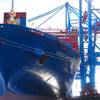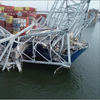Strategic Seaports
Their importance to the nation in a time of need
The U.S. Department of Defense (DOD), in conjunction with the U.S. Department of Transportation’s (DOT) Maritime Administration (MARAD), has designated particular ports around the United States as “strategic seaports.” Strategic seaports are designated because of their ability to support major force and material deployments in times of war and national emergency, based on their proximity to deploying military units and their transportation links close to those units, and varying other capabilities the DOD has deemed important, including the importance of having strategic ports on all four of the nation’s coasts (Atlantic, Gulf, Pacific, and Alaska).
Currently, there are 22 strategic seaports in total; 17 are commercial ports and five are owned by the military. The current list of 22 strategic seaports includes the Ports of Anchorage, AK; San Diego, CA; Long Beach, CA; Hueneme, CA; Oakland, CA; Concord, CA; Jasonville, FL; Savannah, GA; Morehead City, NC; Wilmington, NC; Sunny Point, NC; Port of Port Elizabeth, NJ; Philadelphia, PA; Charleston, SC; Beaumont, TX; Port of Port Arthur, TX; Corpus Christi, TX; Tacoma, WA; Indian Island, WA; Norfolk, VA; Newport News, VA; and Guam.
This article describes how strategic ports are designated by the DOD and MARAD, what needs to be done to ensure that they can continue to carry out their strategic missions while still maintaining their day-to-day commercial missions, and a brief overview of recent Congressional interest in strategic ports.
How Ports are Designated and Examples of their Use by DOD
Strategic seaports are designated as “strategic” because they are significant transportation hubs that are important to the readiness and cargo throughput capacity of the DOD. One of the major responsibilities of strategic seaports is to be prepared to make the port and its facilities available within short notice for the deployment of military forces and supplies in support of DOD operations. MARAD administers the Strategic Port Program and is charged with facilitating the movement of deploying military forces through strategic ports while minimizing commercial disruptions. Within DOD, it is the Surface Deployment & Distribution Command (SDDC), under the purview of the U.S. Transportation Command (USTRANSCOM), that has jurisdiction over the program.
Strategic seaports need to be able to make their facilities available to the military with as little as 48 hours’ notice, and for long periods of time, if necessary. Since the inception of the program, strategic seaports have been used to help deploy troops and materiel. As an example, between 2005 and 2010, the Port of Anchorage has supported over 20 military deployments including Stryker Brigade deployments to Iraq and Afghanistan. During that same time period, over 18,000 pieces of military equipment passed through the Port's facilities. Another example is the Port of Philadelphia, which was one of the four busiest ports serving the Iraq war. During the war, the Port of Philadelphia handled heavy military equipment and weapons headed to the Middle East, including helicopters and fuel tank trucks.
The military is a significantly large cargo shipper, even in peace time. The responsibility that strategic seaports have to the military has the potential to put additional pressure on their infrastructure, facilities and operations, especially as U.S. port cargo traffic continues to increase. Furthermore, as noted in a recent America Society of Civil Engineers (ASCE) report (“Failure to Act – The Economic Impact of Current Investment Trends in Airports, Inland Waterways, and Marine Ports Infrastructure”), our nation’s airports, inland waterways, and marine ports infrastructure investment is not keeping up with the needs of our nation’s waterways and seaports. Total public port investment needs are expected to exceed $30 billion by 2020, but current investment levels by the ports will amount to only $18 billion over that period, leaving a serious gap.
MARAD’s Role in Strategic Port Management and Infrastructure Funding Options
One of the roles of MARAD is to promote U.S. ports and support port infrastructure development. Unfortunately, however, U.S. ports, including strategic seaports, do not have a dedicated source of federal funding for infrastructure and intermodal improvements unlike most other modes of transportation. There was hope that this might change when, in 2009, Congress codified MARAD’s port oversight role by creating the “Port Infrastructure Development Program” (Section 3512 of Pub.L.111-84). The law directed the Secretary of Transportation, acting through the Maritime Administrator, to establish a port infrastructure development program for the improvement of port facilities. The law also established a “Port Infrastructure Development Fund” within MARAD’s purview to receive federal, non-federal, and private funds for port infrastructure. Unfortunately, Congress has not appropriated any funds for this Program and the authority has been languishing.
MARAD and DOT have recently used the “Transportation Investment Generating Economic Recovery” (TIGER) program, a discretionary grant program, to support some infrastructure at ports. Ports, however, have had to compete for limited funds with numerous other transportation projects of national or regional significance and have not fared as well in the competition. The TIGER Program has not been funded for FY2013 as the U.S. Government remains under a Continuing Resolution until March 27, 2013.
The recent two-year reauthorization of the surface transportation reauthorization bill, otherwise known as “MAP 21”, called for the establishment of a new freight mobility program, including the development of a National Freight Strategic Plan. However, DOT does not expect the Plan will be fully developed for another five years! MAP 21 also authorizes ports to derive funds, in certain circumstances, from federal Surface Transportation Program (STP) formula funds—authorized at $20 billion under MAP 21—allocated to states.
However, without a specific allocation for ports, they will once again have trouble competing at the state level with traditional highway projects.
DOT is also investigating whether its “Transportation Infrastructure Finance and Innovation Act” (TIFIA) loan program may be available to finance port infrastructure. TIFIA was reauthorized by MAP-21 at $1.7B over two years.
Congressional Interest in Strategic Ports and Roundtable Discussion
Capitol Hill has been engaged on the issue of strategic ports and port infrastructure funding in the last few years. As mentioned above, Congress created a “Port Infrastructure Improvement Program” in the Fiscal Year (FY) 2010 National Defense Authorization Act (NDAA); however, that program has yet to be funded. In addition, Congress mandated studies from the SDDC about the status of our nation’s strategic port infrastructure, including identifying any needed upgrades or issues that should be addressed. Language was included in the FY12 NDAA that requires a broader examination of strategic ports, including a requirement to identify potential funding sources for needed port infrastructure improvements. This updated report is yet to be released by the SDDC.
On October 18, 2012, the Congressional Ports Caucus, co-chaired by Congressman Ted Poe (R-TX) and Congresswoman Janice Hahn (D-CA), whose districts include strategic ports, hosted a Roundtable with the American Association of Port Authorities (AAPA) on Capitol Hill to educate Members of Congress and Congressional staff on the importance of strategic ports. The Roundtable provided an opportunity for face-to-face dialogue between representatives of strategic ports and the agencies that support them, including DOT, DOD, DHS, and the Army Corps of Engineers. Outcomes of the Roundtable include a heightened appreciation of the importance of strategic ports, the challenges they face balancing their commercial and military cargo commitments, and an agreement to work together on a new financing solution for funding infrastructure at strategic ports.
Next Steps & Conclusions
While Congress has a host of issues to address it before the end of the year and into next year, including the so-called “fiscal cliff”, we should not lose sight of the importance of funding the infrastructure needed to maintain and improve our strategic ports. The DOD is counting on our ports to be ready whenever they need to move personnel and materiel to the next hot spot. Our strategic ports have met their half of the bargain—being available to DOD when the military and the nation call on them. The other half must be met by helping our ports meet their critical infrastructure improvement and modernization needs.
(As published in the December 2012 edition of Maritime Reporter - www.marinelink.com)

















